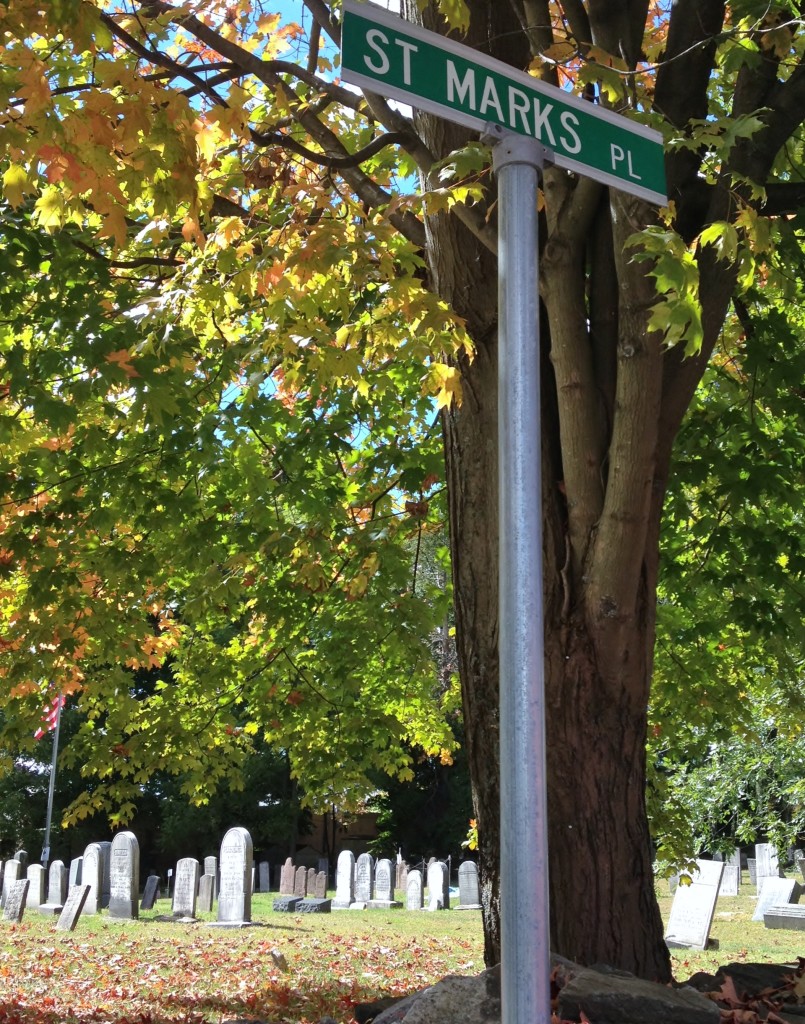It’s easy to cruise right past the tiny little cemetery at the corner of St. Marks Place and Main Street in Mount Kisco without noticing the Revolutionary War-era grave markers. Situated just across and down a bit from Friendly’s at the corner by Conte’s Fish Market, on the way to the bagel store and T.J. Maxx, the somewhat rundown cemetery is easily dismissed. You’re already past it before you remember to think, Say a prayer when you pass a graveyard.

No church currently stands at the St. George’s cemetery at St. Marks Place in Mount Kisco, N.Y.
Photo credit: L. Tripoli
Walk the grounds, though, to appreciate the history of this place. A marker by the entrance makes mention of the church that is no longer there, the one that predates the United States. Built in 1761 as an Anglican house of worship in what was then known as North Castle, St. George’s was used as a hospital after the Battle of White Plains.

A brief history of the St. George’s (and later, St. Mark’s) cemetery is provided at the entrance to the graveyard.
Photo credit: L. Tripoli
At a talk given by members of the Mount Kisco Historical Society, I learned about the church’s past and the graveyard’s inhabitants while picking up pieces of our revolutionary past. What I learned in elementary school about the founding of the United States was about a very neat war, about a band of principled farmers taking on those British Redcoats. It was sort of like the U.S. Olympic Hockey Team versus the U.S.S.R. at the 1980 Winter Olympics. It was a tough battle, but the underdogs won. No one mentioned blood on the ice. I definitely don’t remember learning much about casualties or about how long the American Revolution lasted.
It’s no surprise that it was a bit dirtier than the scenario school children are presented with. Portions of Westchester were a “neutral ground,” meaning not that this was Switzerland but that no side had definitively claimed it. The British had portions of the southern county; the Patriots the north. In between, there were raids and lawlessness. “The History of Westchester County during the Revolutionary War is a record of fighting and suffering,” wrote Otto Hufeland in his 1926 book, Westchester County during the American Revolution 1775~1783. The “scene of numberless petty raids and bloody skirmishes,” Hufeland observed, Westchester’s “troubles began in the earliest days of the struggle and did not end until the very day that the enemy left these shores.” A reminder of the violence is preserved on a marker at the little cemetery in Mount Kisco.
Now, the Mount Kisco Historical Society and the New York State Archaeological Association are conserving the cemetery and researching the history of its inhabitants and of the churches that once stood there. Founded as Anglican St. George’s, its Revolution-era reverend, Ephraim Avery, was a Loyalist whose exhortation to pray for King George didn’t go over so well with the congregation’s Patriots. He was found dead in Rye with his throat cut in 1776. Anglicanism wasn’t so popular after the Revolution, and the church foundered and was taken down, to be replaced in 1852 by St. Mark’s Episcopal Church a bit further back on the grounds. That lasted until 1911. (The “new” St. Mark’s is at Main Street and North Bedford Road.) The history, though, lingers, and should be revisited.
—Lori Tripoli



Thanks for posting about this historic site, and our efforts to educate people about it, and save it!